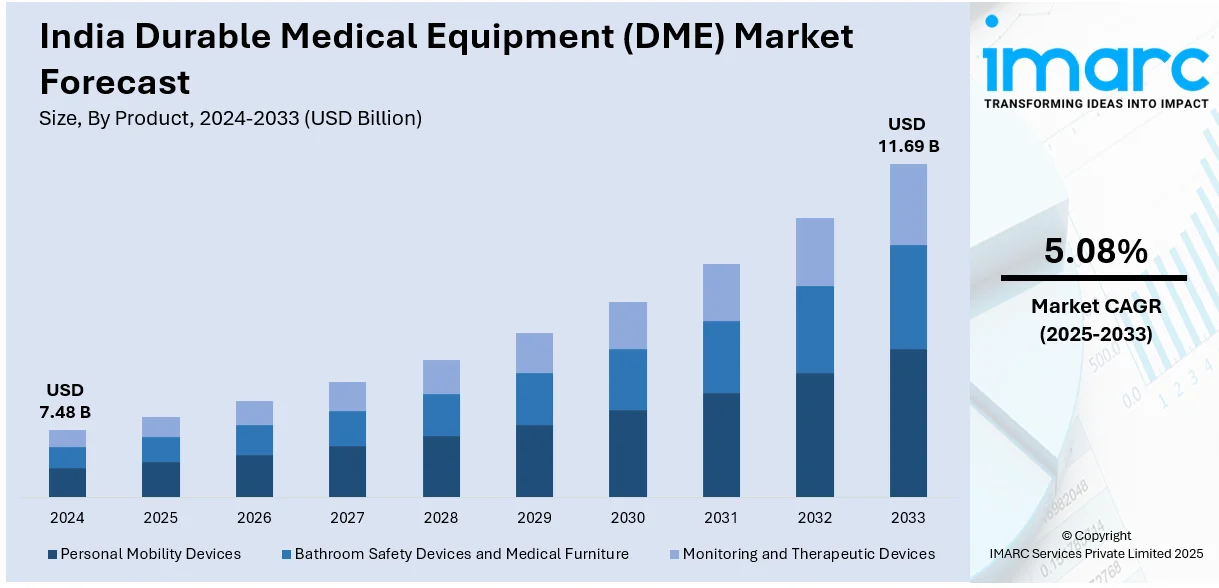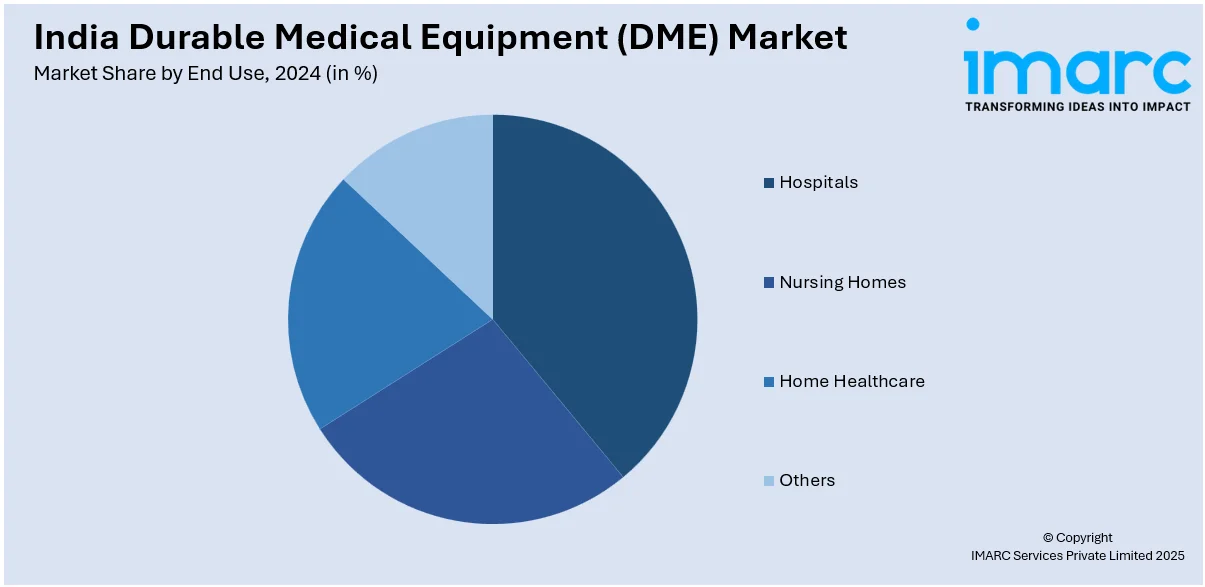
India Durable Medical Equipment (DME) Market Size, Share, Trends and Forecast by Product, End Use, and Region, 2025-2033
India Durable Medical Equipment (DME) Market Overview:
The India durable medical equipment (DME) market size reached USD 7.48 Billion in 2024. Looking forward, IMARC Group expects the market to reach USD 11.69 Billion by 2033, exhibiting a growth rate (CAGR) of 5.08% during 2025-2033. The market is driven by a growing aging population, rising incidence of chronic diseases, and increasing healthcare infrastructure development. Expanding health insurance coverage and government initiatives supporting elderly care further boost demand. Additionally, technological advancements and rising awareness about home healthcare solutions are propelling market growth.
|
Report Attribute
|
Key Statistics
|
|---|---|
|
Base Year
|
2024
|
|
Forecast Years
|
2025-2033
|
|
Historical Years
|
2019-2024
|
| Market Size in 2024 | USD 7.48 Billion |
| Market Forecast in 2033 | USD 11.69 Billion |
| Market Growth Rate (2025-2033) | 5.08% |
India Durable Medical Equipment (DME) Market Trends:
Rise in Home Healthcare Solutions
One of the most prominent trends shaping the India durable medical equipment (DME) market is the growing demand for home healthcare solutions. This shift is largely driven by India’s aging population, with seniors accounting for nearly 60–80% of the home care demand. There is an increasing focus on preventive health, early intervention, and rehabilitative care, prompting the adoption of equipment such as mobility aids, respiratory support devices, and patient monitoring systems in home settings. Patients and caregivers prefer cost-effective, convenient alternatives to prolonged hospital stays, leading to innovations in compact, user-friendly medical devices. The COVID-19 pandemic further accelerated this trend, positioning home-based care as a long-term model. Additionally, telehealth platforms are enhancing this ecosystem by offering remote diagnostics and real-time equipment usage guidance, making home healthcare integral to India’s DME landscape.

Integration of Advanced Technology in Equipment
Technology innovation is one of the key trends in India's durable medical equipment industry. Manufacturers are integrating innovative features like IoT capability, remote monitoring, and AI-based diagnostics into legacy equipment to enhance patient results and alleviate the workload of healthcare providers. For example, smart wheelchairs, mobile app-enabled oxygen concentrators, and artificial intelligence (AI)-driven CPAP machines are increasingly popular. Such innovations improve operational efficiency, real-time monitoring, and one-on-one care delivery. The movement is also underpinned by the increasing tech-savviness of healthcare professionals and patients, along with the government's initiative toward digitalized healthcare. With consumers looking for products that provide both clinical accuracy and digital convenience, technology-rich products are emerging as a differentiator in the competitive DME industry.
Growth of Rental and Subscription Models
One of the major trends in the India DME market is the surging move towards rental and subscription models of equipment. As medical equipment tends to cost high initial investment, particularly unaffordable for rural and lower-income communities, rental options present a less costly and affordable option. Patients now have the means to utilize essential equipment such as wheelchairs, hospital beds, oxygen concentrators, and nebulizers without straining their pockets. Subscription-based models, which have grown revenue by 437% over the last ten years in India, are also becoming popular for long-term usage with bundled services like maintenance, delivery, and support. Technology advancements and the emergence of digital payments have further accelerated this movement, allowing digital platforms and startups to make access seamless, which in turn encourages wider market reach and user ease.
India Durable Medical Equipment (DME) Market Segmentation:
IMARC Group provides an analysis of the key trends in each segment of the market, along with forecasts at the region level for 2025-2033. Our report has categorized the market based on product and end use.
Product Insights:
- Personal Mobility Devices
- Wheelchairs
- Scooters
- Walker and Rollators
- Cranes and Crutches
- Door Openers
- Others
- Bathroom Safety Devices and Medical Furniture
- Commodes and Toilets
- Mattress and Bedding Devices
- Monitoring and Therapeutic Devices
- Blood Sugar Monitors
- Continuous Passive Motion (CPM)
- Infusion Pumps
- Nebulizers
- Oxygen Equipment
- Continuous Positive Airway Pressure (CPAP)
- Suction Pumps
- Traction Equipment
- Others
The report has provided a detailed breakup and analysis of the market based on the product. This includes personal mobility devices (wheelchairs, scooters, walker and rollators, cranes and crutches, door openers, others), bathroom safety devices and medical furniture (commodes and toilets, mattress and bedding devices), monitoring and therapeutic devices (blood sugar monitors, continuous passive motion (CPM), infusion pumps, nebulizers, oxygen equipment, continuous positive airway pressure (CPAP), suction pumps, traction equipment, others).
End Use Insights:

- Hospitals
- Nursing Homes
- Home Healthcare
- Others
A detailed breakup and analysis of the market based on the end use have also been provided in the report. This includes hospitals, nursing homes, home healthcare, and others.
Regional Insights:
- North India
- South India
- East India
- West India
The report has also provided a comprehensive analysis of all the major regional markets, which include North, South, East, and West India.
Competitive Landscape:
The market research report has also provided a comprehensive analysis of the competitive landscape. Competitive analysis such as market structure, key player positioning, top winning strategies, competitive dashboard, and company evaluation quadrant has been covered in the report. Also, detailed profiles of all major companies have been provided.
India Durable Medical Equipment (DME) Market News:
- In August 2024, The Indian government is set to launch a new scheme aimed at boosting the domestic medical device industry and reducing dependency on imports. Announced by Arunish Chawla, Secretary of the Department of Pharmaceuticals, the initiative was shaped through extensive stakeholder consultations. It focuses on promoting self-reliance and long-term growth in the sector. The scheme is tailored to address industry-specific needs, fostering a stronger, more resilient medical device manufacturing ecosystem in India.
- In April 2024, IIT Madras launched India’s first mobile medical devices calibration facility under its ‘Anaivarukkum IITM’ initiative. This innovative unit aims to ensure accurate diagnosis and treatment by offering affordable, on-site calibration services, reducing time and transportation costs. Equipped with advanced tools, it supports hospitals across rural and urban areas, enhancing healthcare quality. This first-of-its-kind facility promotes accessible, reliable medical device maintenance and aligns with global health and well-being goals.
India Durable Medical Equipment (DME) Market Report Coverage:
| Report Features | Details |
|---|---|
| Base Year of the Analysis | 2024 |
| Historical Period | 2019-2024 |
| Forecast Period | 2025-2033 |
| Units | Billion USD |
| Scope of the Report | Exploration of Historical Trends and Market Outlook, Industry Catalysts and Challenges, Segment-Wise Historical and Future Market Assessment:
|
| Products Covered |
|
| End Uses Covered | Hospitals, Nursing Homes, Home Healthcare, Others |
| Regions Covered | North India, South India, East India, West India |
| Customization Scope | 10% Free Customization |
| Post-Sale Analyst Support | 10-12 Weeks |
| Delivery Format | PDF and Excel through Email (We can also provide the editable version of the report in PPT/Word format on special request) |
Key Questions Answered in This Report:
- How has the India durable medical equipment (DME) market performed so far and how will it perform in the coming years?
- What is the breakup of the India durable medical equipment (DME) market on the basis of product?
- What is the breakup of the India durable medical equipment (DME) market on the basis of end use?
- What is the breakup of the India durable medical equipment (DME) market on the basis of region?
- What are the various stages in the value chain of the India durable medical equipment (DME) market?
- What are the key driving factors and challenges in the India durable medical equipment (DME)?
- What is the structure of the India durable medical equipment (DME) market and who are the key players?
- What is the degree of competition in the India durable medical equipment (DME) market?
Key Benefits for Stakeholders:
- IMARC’s industry report offers a comprehensive quantitative analysis of various market segments, historical and current market trends, market forecasts, and dynamics of the India durable medical equipment (DME) market from 2019-2033.
- The research report provides the latest information on the market drivers, challenges, and opportunities in the India durable medical equipment (DME) market.
- Porter's five forces analysis assist stakeholders in assessing the impact of new entrants, competitive rivalry, supplier power, buyer power, and the threat of substitution. It helps stakeholders to analyze the level of competition within the India durable medical equipment (DME) industry and its attractiveness.
- Competitive landscape allows stakeholders to understand their competitive environment and provides an insight into the current positions of key players in the market.
Need more help?
- Speak to our experienced analysts for insights on the current market scenarios.
- Include additional segments and countries to customize the report as per your requirement.
- Gain an unparalleled competitive advantage in your domain by understanding how to utilize the report and positively impacting your operations and revenue.
- For further assistance, please connect with our analysts.
 Inquire Before Buying
Inquire Before Buying
 Speak to an Analyst
Speak to an Analyst
 Request Brochure
Request Brochure
 Request Customization
Request Customization




.webp)




.webp)












